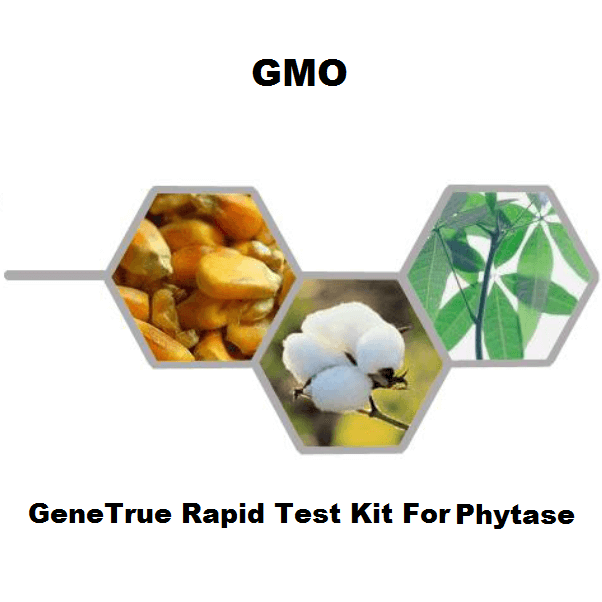PROPERTIES
PRODUCT DESCRIPTION
INTENDED USE
The GeneTrue Rapid test Kit for Phytase is intended to determine the presence of Phytase in genetically modified organisms.
Phytase is currently used as an additive in animal feed to breakdown phytic acid in corn, which holds 60% of the phosphorus in corn. Phytase increases phosphorus absorption in animals by 60%. Phosphorus is an essential element for the growth and development of all animals, and plays a key role in skeletal structures and vital metabolic pathways. Phytase, as an additive for animal feed, is mandatory in Europe, Southeast Asia, South Korea, Japan, and other regions for environmental purposes. Phytase transgenic corn, developed by and licensed from Chinese Academy of Agricultural Science (CAAS) after a 7 year study, will allow animal feed producers the ability to eliminate purchasing phytase and corn separately. It will eliminate the need for mixing the two ingredients together, saving time, machinery, and labor for the animal feed producers
Limit of detection: 1 ng/ml or 1 in 1000 Kernels
STORAGE
The Rapid test Kit should be stored and sealed in its container between 2-30°C. It is recommended to store the strip in the refrigerator (4?C) between uses, prolonging its shelf life. For best results, keep the strip in dry before use.
CONTENTS
Pouch (contains: test strip and dessicant) Test instructions
MATERIALS REQUIRED (BUT NOT PROVIDED)
TECHNICAL SPECIFICATIONS
SAMPLE PREPARATION
Preparation of the sample is a crucial step for the test to run effectively. To prepare the sample, first grind the plant seeds/ leaves/ seedlings/ other materials that need testing.
For plant components that are not listed below, please refer to the table and draw inferences by selecting the closest component category that would be most applicable for the sample. After completing the process of grinding the sample and adding water, ensure that the sample is mixed properly. This can be done by shaking or centrifuging the test tube. Once this has been accomplished, allow the mixture to stand for a while. It is recommended that you remove the liquid (supernatant) fraction of the ground plant mixture to another container for testing.
* For single seed types:
Ground a single seed sample (0.5-2 g ground seeds) in a container and add water or buffer. Mix for 15–25 seconds and let the sample settle before testing.
* For a mixture of different seed types:
Grind 200 g of mixed seeds. In a beaker, combine 20-50 g of the ground sample with water or buffer. Mix for 2-5 minutes and let the sample settle before testing.
* For leaf tissue from the single plant type:
Take a 1-inch x 1-inch leaf punches from the sample leaf tissue (0.15g); push the leaf punches into the tube using a pestle. Add 3 mL of water or buffer into tube and grind the tissue using the pestle. This will result in a dilution of 1:20, if 0.15 g. Let the paste settle for at least 45 seconds before testing or further dilution with water or buffer.
* For leaf tissue from a mixture of different plant types:
Take a 1-inch x 1-inch leaf punches from each of the different sample leaf tissue (total 0.2-0.4 g); push the leaf punches into the tube using a pestle. Add 4mL of water or buffer into tube and grind the tissue using the pestle. This will result in a dilution of 1:20, if 0.2 g or 1:10, if 0.4 g. Let the paste settle for at least 45 seconds before testing or further dilution with water or buffer.
HOW TO RUN THE STRIP TEST
* Remove the testing device from the foil pouch by tearing at the notch. Hold the strip at the colored end. Do not touch the arrow end or the test window (the middle part of the strip).
* Holding the strip vertically, immerse the end of the strip with the arrows into the sample liquid. Do not immerse past the MAX line.
* Take the strip out when the sample has migrated to the test window (about 10 seconds). Lay the strip (MAX side facing up) flat on a clean, dry, non-absorbent surface.
* Wait 2-5 minutes for the result. If there is only one line appears, allow the strip to develop for an extra 10 minutes before completion of the test. Results visible after 30 minutes are considered invalid.



